A Look Back on the Teenage Mutant Ninja Turtles Movies
Forty years ago, no one thought of let alone heard of the phrase Teenage Mutant Ninja Turtles. However, that all changed in 1983 when Kevin Eastman drew a single image. This image was a bipedal turtle with nunchaku attached to its arms. His partner-in-crime, Peter Laird, cracked up at the image along with the included caption: “Ninja Turtles”. Thus, the two began to draw more and more pictures of turtles with ninja weapons. Eventually, Kevin Eastman drew a group of four turtles that added the phrase “Teenage Mutant” to the “Ninja Turtles”. Deciding that they had landed on a winning idea, the pair began to flesh out the idea.
Feeling confident in the Teenage Mutant Ninja Turtles, the pair founded Mirage Studios before publishing the first issue in May 1984. The four teenage mutants, who were named after renaissance painters, became an instant hit. SO, they quickly sold out all three thousand copies that were available to store. Fueled on by the success, Eastman and Laird continued to churn out new issues of the Ninja antics.
As the comics grew in popularity, the pair decided that they could expand their popularity by licensing out their Turtles to a toy company. By 1987, they teamed up with Playmates Toys to create the first line of Teenage Mutant Ninja Turtles toys. However, Playmates decided that the mature-toned comics alone would not help them sell toys. Thus, they approached Murakami-Wolf-Swenson to produce the first cartoon series for the Ninja Turtles, which also became a massive hit.
As the cartoon overshadowed the popularity of Mirage Studio’s comics, the Teenage Mutant Ninja Turtles became a cultural hit. So, it was only a matter of time before they began showing up in other media, like movies.
Join us as we look back at the Teenage Mutant Ninja Turtles movies
Teenage Mutant Ninja Turtles (1990)
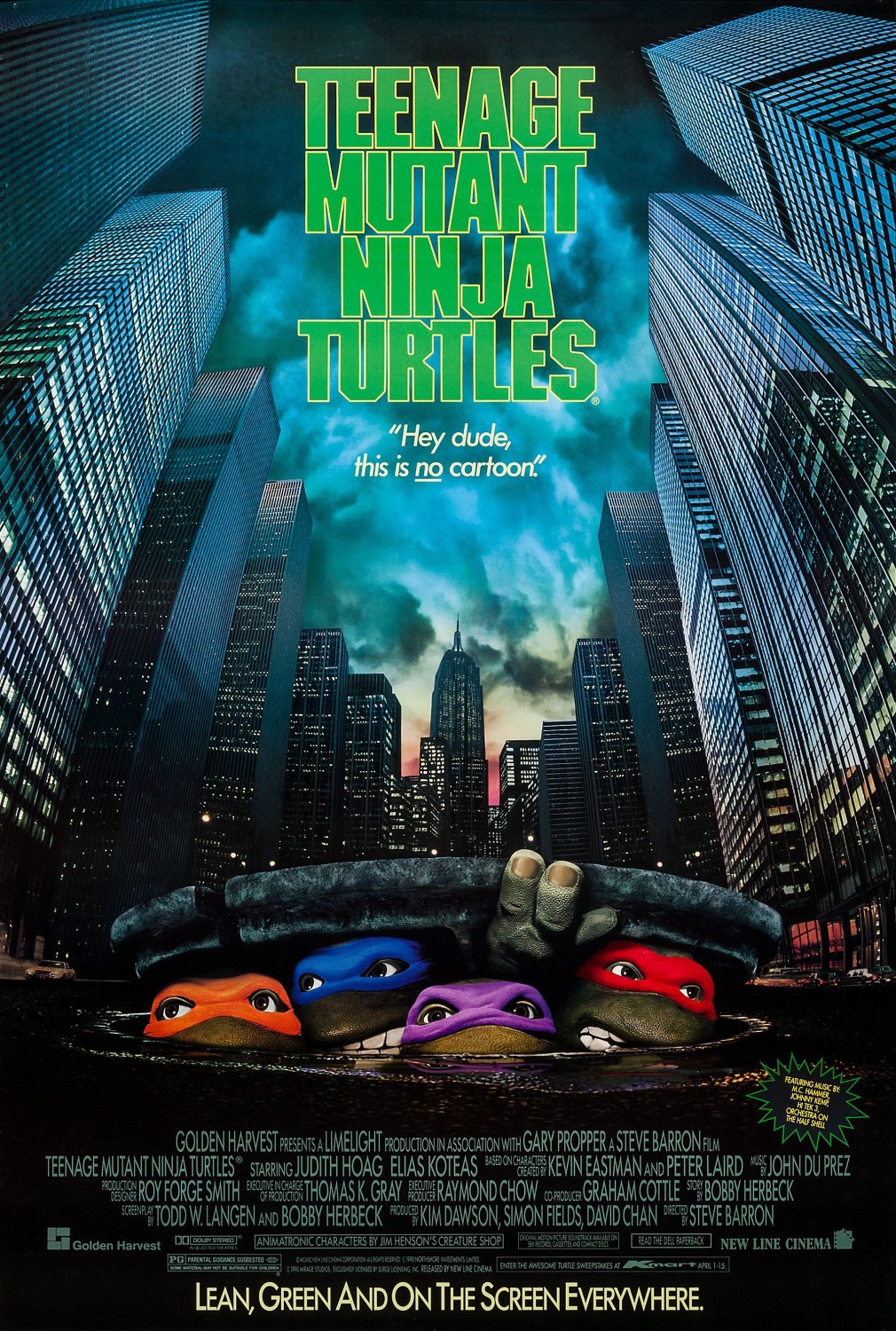
At the height of the Turtles’ first wave of popularity, New Line Cinema created another smash hit as they debuted the live-action Teenage Mutant Ninja Turtles movie. While this movie quickly became a smashing hit, the production struggled to even find a publisher for the film. Early on, Gary Propper became enamored by Mirage Comic’s Teenage Mutant Ninja Turtles. Determined to turn the idea into a movie, he convinced Kim Dawson to join him as the producer of the film. He also enlisted Bobby Herbeck to write the script.
While Gary Propper enthusiastically wanted to introduce the Turtles to movie-goers, most studios wanted nothing to do with the film. Still, the production continued with the aid of Jim Henson Creature Shop, who created the suits for the Turtles. Meanwhile, they enlisted Steve Barron to become the film’s director. Eventually, New Lines Studios, a small, independent publishing studio, signed on to distribute the film to cinema screens.
On March 30, 1990, the Teenage Mutant Ninja Turtles debuted at cinemas. There, they quickly made back the $13.5 million budget, garnering $202 million in total. While the film took a few elements from the cartoon series, such as the different colored bandanas, it remained true to the comics’ dark origins. For instance, the film ended with the Shredder falling into a dumpster truck before Casey Jones activated the crushing mechanism. Also, Raphael received life-threatening injuries and hung on the brink for a substantial portion of the film.
Teenage Mutant Ninja Turtles II: The Secret of the Ooze (1991)
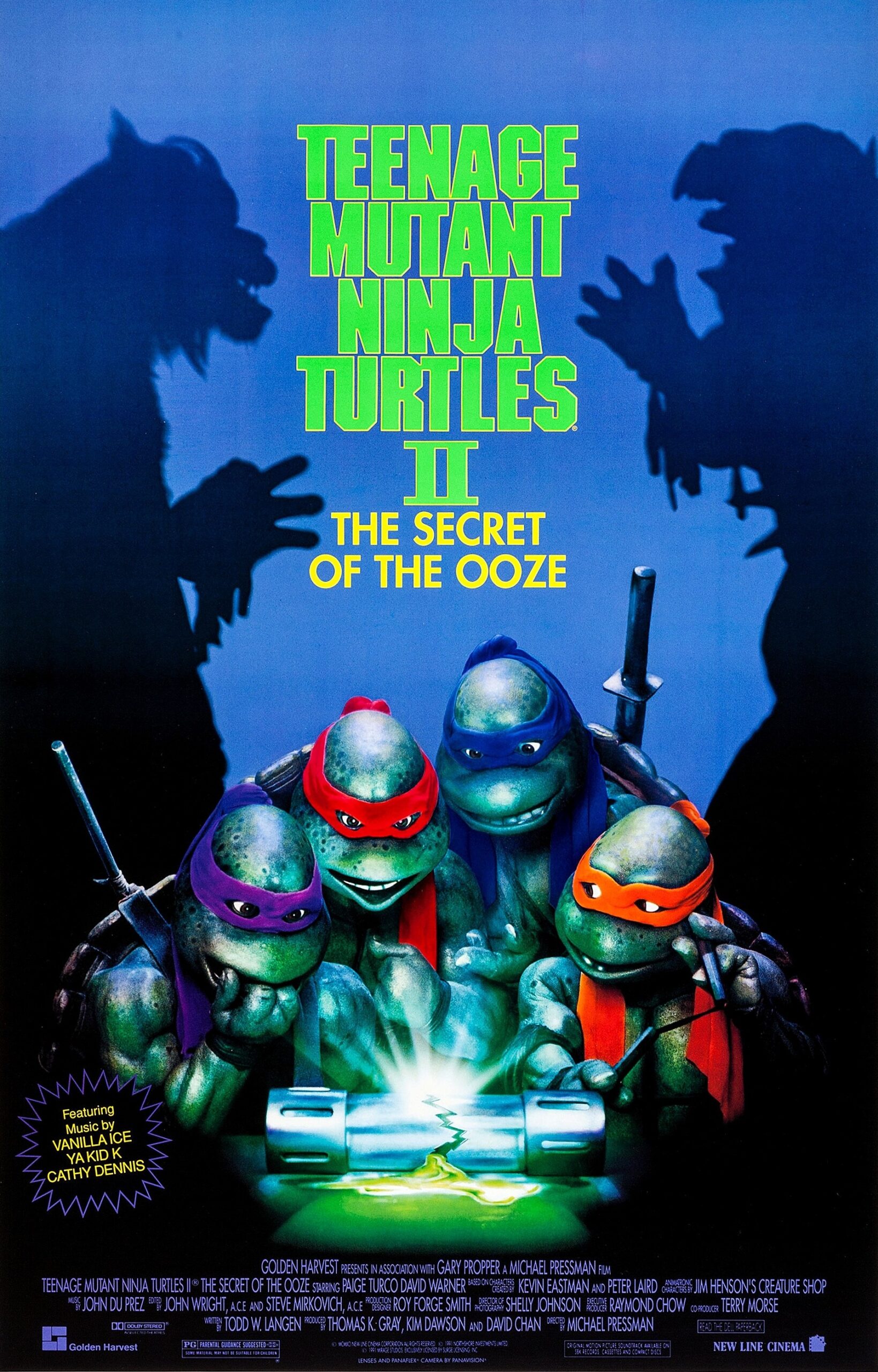
Fearing that waiting too long would ruin any momentum that the first film had generated, New Line Cinema and Golden Harvest quickly moved to release the sequel. So, Todd Langen, who had assisted with rewrites of the original, returned to quickly draft the follow-up. Even as the production quickly pulled together loose ideas for the follow-up, Peter Laird carefully looked over the script and other elements to maintain the integrity of the brand.
While the producers felt that this film would be a wonderful time to introduce fan-favorite characters, Bebop and Rocksteady, they also wanted to generate new merchandise. Thus, they decided to introduce two new villains to the franchise, Tokka and Rahzar. Since the production did not need to license new characters, they would get more money from sales of merchandise that featured these two new monsters.
Meanwhile, multiple media outlets had begun to question the influence of the Teenage Mutant Ninja Turtles on children. Many places, such as preschools, had begun to ban Turtles products because they felt that the reptiles promoted violence. Moreover, the UK had deemed the “Ninja” part of the name too violent for children, thus they dubbed the team the Teenage Mutant Hero Turtles. With so much outside pressure, the script underwent rewrites to reduce the violence.
Thus, while the Secret of the Ooze expanded the world of the Turtles films, it also took several steps back to create a kid-friendly atmosphere. The dark tone of the original was set aside so that the Turtles would infrequently use their weapons. Still, the sequel made back its budget and more, as it grossed $78.6 million domestically.
Teenage Mutant Ninja Turtles III (1993)
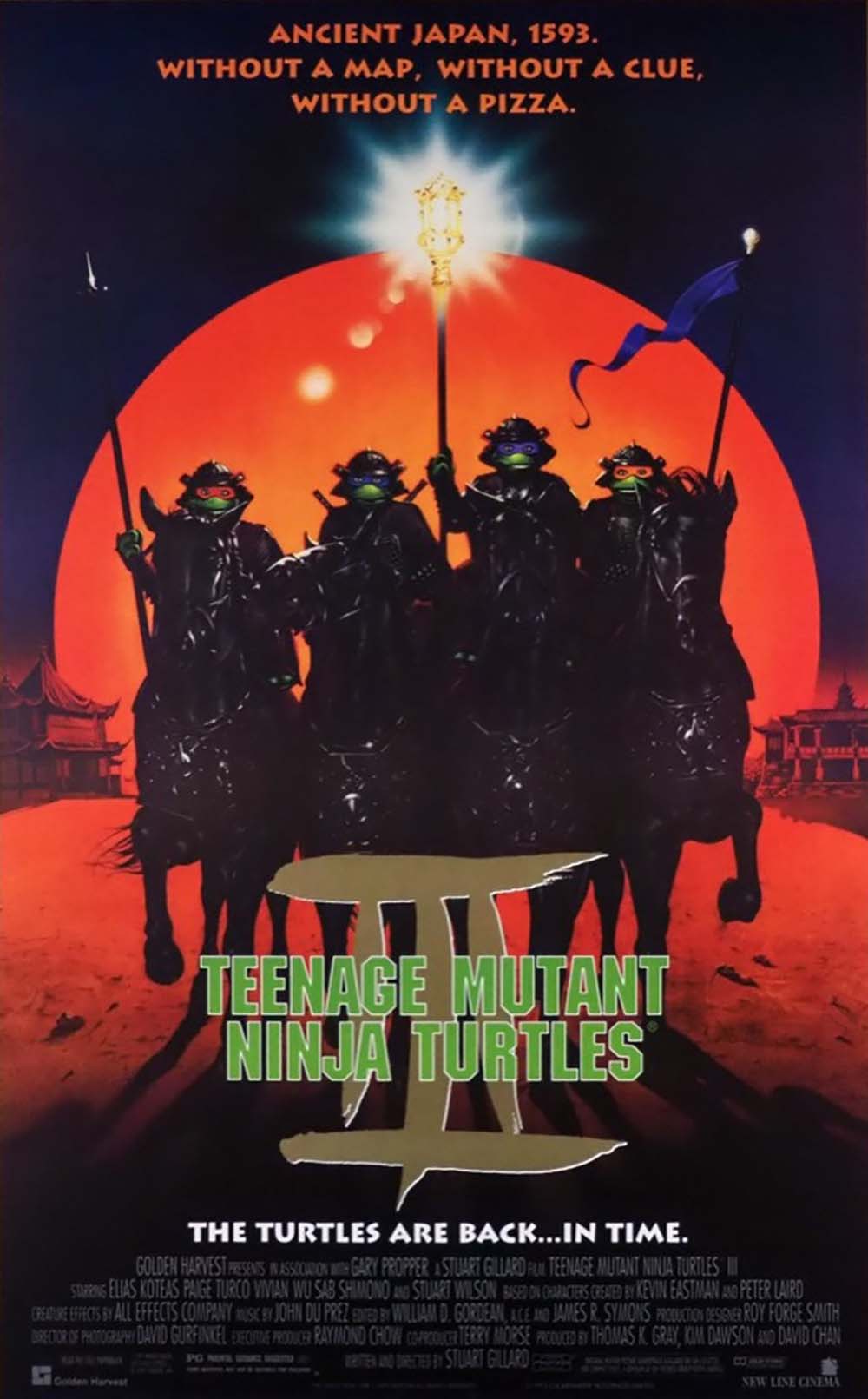
Even though the Secret of the Ooze was not as successful as the first film, its success paved the way to a third film in the series. This time, the production decided to give the sequel some time to breathe before it came out in movie theaters. Thus, Turtles fans had to wait until 1993 before they would have the chance to watch their favorite reptiles on the big screen once more.
While this film still had a larger budget than the original, the $21 million budget was a significant downsize to the prior’s $25 million budget. New to the franchise, Stuart Gillard joined the production as both the director and writer for this film. Having lost the connections to the original films, the script struggled to keep the tone set by the first two. In some ways, this film took a darker edge to the second; however, it contained an abundance of slapstick and poorly delivered quips.
Worse than the inconsistent script, the animatronics for this film did not have the polish of the first two. For instance, the eyeholes for the actors, located under the headbands, were plainly visible in most shots. Worse yet, Splinter no longer had a detailed animatronic puppet. Instead, he resembled a cheap stuffed animal that sat around the Turtles’ lair.
Moreover, while the first two films featured the Turtle’s main villain, the Shredder, this film took the turtles back to feudal Japan. Thus, it featured no villains that fans could easily recognize from either the cartoon or comics. To say the least, this film’s $54.4 million box office put the nail in the coffin for this series.
TMNT (2007)
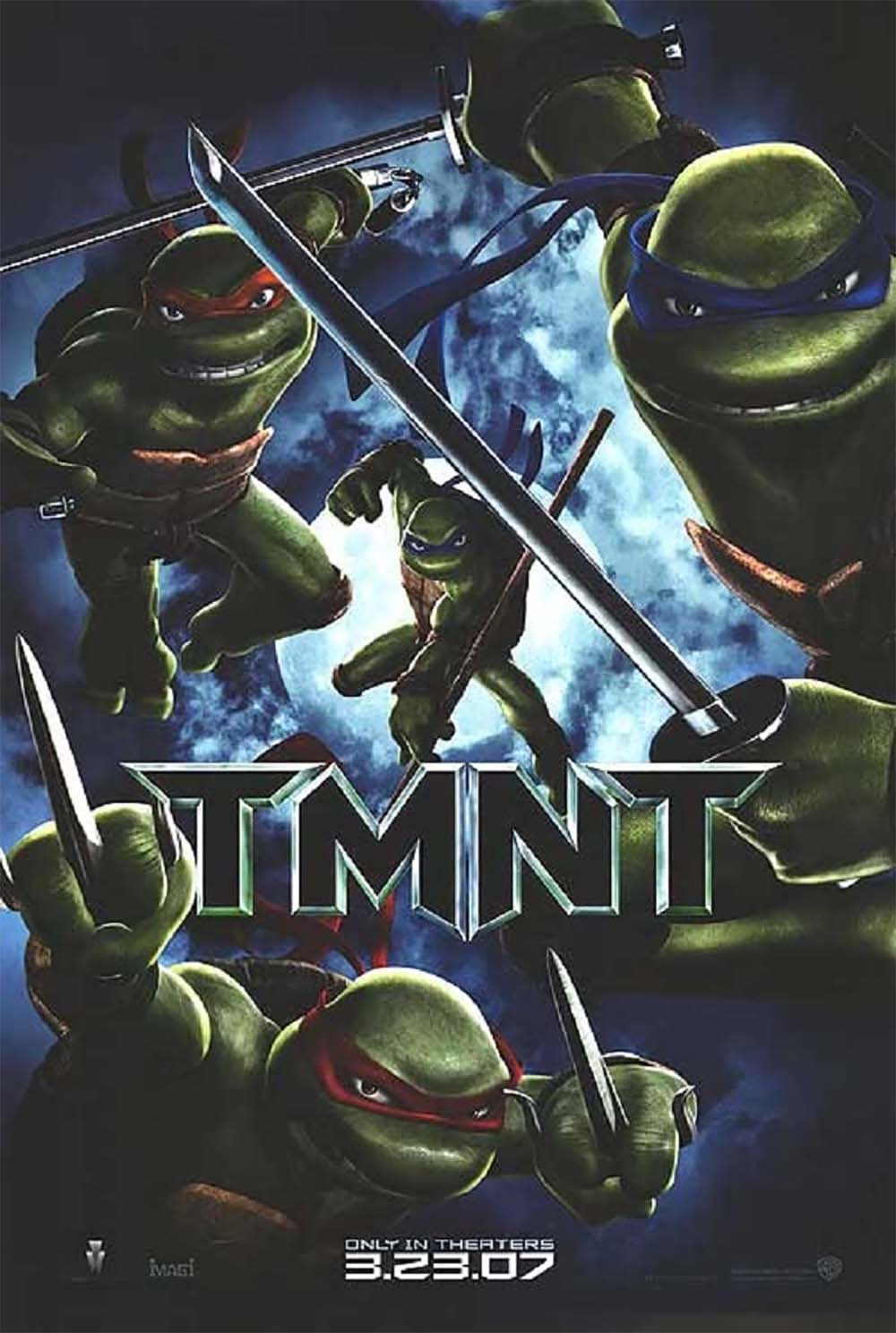
After over a decade of waiting, Teenage Mutant Ninja Turtles fans were treated by the first new cinematic version of their favorite reptiles in 2007. While the Turtles had moved into a new generation of cartoons, under Fox Kids’ production, the movie held no connections to that series. While this new film had many similarities to the original trilogy, notable additions like Karai made it stand out as a new timeline.
In the interest to avoid the skyrocketing production costs behind live-action films, the production team agreed that this film would work best in CGI. Having decided to animate the film, they then decided to give the film a feel that harkened back to Mirage Studios’ original comics. Thus, the film gained a dark noir feel that the live-action films had lost as the sequels came out.
Meanwhile, Kevin Monroe took on the mantle to draft the script for this new iteration of the Teenage Mutant Ninja Turtles. While he had considered moving the adventure into space, he eventually decided to ground the Turtles in their home, New York City. However, this time, the family had broken apart, with each turtle living their own separate lives. However, between Leonardo’s return to the city and a series of supernatural disturbances, the four turtles reforged their bonds.
Meanwhile, April O’Neal took on a brand-new role for the films. While the comics and newer cartoons featured an April who trained in ninjitsu, the Turtles media of the nineties relegated her to only being a reporter. So, it was a breath of fresh air when April picked up her katana to join the fight.
Teenage Mutant Ninja Turtles (2014)

Soon after acquiring Mirage Studios in 2009, Nickelodeon began imagining a new spin on the Turtles for the cinema. With Viacom owning both Nickelodeon and Paramount Pictures, they began production on the new film at Paramount, quickly pulling in Michael Bay as a collaborator. While the final film still had that special Bay flavor, he did not direct this film. Instead, Jonathan Liebesman sat in the director’s seat for this reboot.
Even during the early announcements for this film, fans doubted that Michael Bay would produce a film that was faithful to the original. In part, Michael Bay’s nonsensical Transformers movie franchise set the precedence that Bay would choose style over any substance. Not to mention, early announcements concerning the script indicated that the Turtles would be members of an alien race.
Even as fans raged over the reported changes in the Turtles’ backstory, Michael Bay and his production team lobbied for them to wait until the release of the final film. In many instances, they tried to assure fans that the changes would create a fun and interesting take on the mutant reptiles. Luckily, with the leak of a version of the script, named “The Blue Door,” the production pulled back from any extreme changes to the characters.
One final controversy hit the film as William Fichtner announced that he was set to play Eric Sacks, the Shredder. This sat well with neither the fans of the franchise nor those who dislike whitewashing in films. Interestingly, he does not play the Shredder in the final film, but his role in the film hints that the production originally shot his scenes with that intention. Instead, the production team quickly cast Tohoru Masamune to appear as the iconic villain.
Teenage Mutant Ninja Turtles: Out of the Shadows (2016)
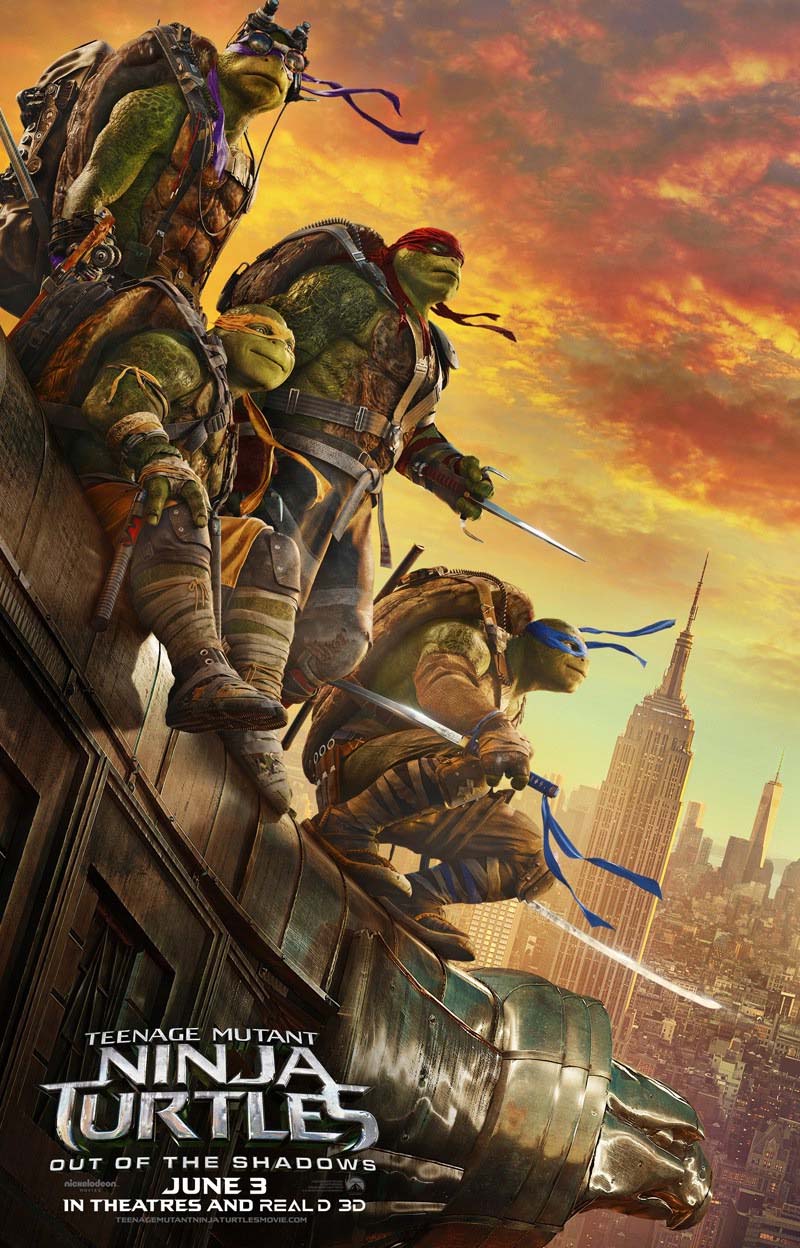
Love it or hate it, the 2014 reboot film was a financial success, grossing $493.3 million at the box office. Thus, Paramount began moving forward with a sequel to the hit film. However, Jonathan Liebesman did not return to direct Teenage Mutant Ninja Turtles: Out of the Shadows. Instead, Dave Green came in to sit in the director’s chair.
Moving the series forward, the sequel decided to introduce multiple fan-favorite characters from the franchise. Thus, Tyler Perry joined the cast as Baxter Stockman, the mad scientist from the comics and cartoons. Meanwhile, Stephen Amell took on the role of Casey Jones, the sports-loving vigilante who often fights alongside the Turtles.
However, many fans perked up when they heard that the movie would be featuring Stephen Farrelly as Rocksteady and Gary Anthony Williams as Bebop. These two mutants had never made a cinematic appearance, even though they had been fan favorites from the 1990s cartoon. Thus, the movie generated excitement over finally seeing these characters on the silver screen.
This film also offered one more first-time appearance to the Turtles movies, Krang along with hints of the Technodrome and Dimension X. Brad Garret provided the voice for the interdimensional villain. However, Krang mostly appeared as a final last-minute villain for the film.
While this film also proved to be a financial success, it fell far shorter than the original reboot with a box office of $245.6 million. Thus, those who despise Michael Bay and his takes on the franchise may rest easy knowing that Paramount plans to reboot the franchise again.
The future of Teenage Mutant Ninja Turtles films
As of drafting this article, none of the proposed reboots for the cinematic Teenage Mutant Ninja Turtles films, whether animated or live-action, are still deep in the development phases. The next film, whether it comes to Netflix or another format, is not likely to emerge for several years.
Instead, there have been smaller animated films, like Batman vs. The Teenage Mutant Ninja Turtles, which have garnered love from the fanbase. With hope, the next films to hit theaters will hold the respect and love for the franchise that flowed through this film.
Do you have old and used Teenage Mutant Ninja Turtles toys?
If you have a collection of old and used toys, you can turn those toys into cash. There is no reason to let those old toys collect dust. Contact us today to sell your Teenage Mutant Ninja Turtles toy collection.
About the Author
Chris Ingledue is the founder and owner of Wheeljack’s Lab pop Culture and Toy Shop. His vision has always been to reunite customers with their favorite childhood toys and pop culture, triggering fond memories, and reigniting their imaginations. Every day he works in the “lab” where it’s Christmas 365 days a year; scouring the internet – like we did the Sears Catalog of yesteryear – for the next great treasure, awaiting the arrival of the postman as if he was Santa Claus himself and helping collectors worldwide with their own versions of Christmas. For Chris, every day as a vintage toy buyer is an absolute joy!